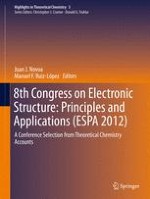2014 | OriginalPaper | Chapter
A theoretical analysis of the magnetic properties of the low-dimensional copper(II)X2(2-X-3-methylpyridine)2 (X = Cl and Br) complexes
Authors : Sergi Vela, Mercé Deumal, Mark M. Turnbull, Juan J. Novoa
Published in: 8th Congress on Electronic Structure: Principles and Applications (ESPA 2012)
Publisher: Springer Berlin Heidelberg
Activate our intelligent search to find suitable subject content or patents.
Select sections of text to find matching patents with Artificial Intelligence. powered by
Select sections of text to find additional relevant content using AI-assisted search. powered by
The First-principles Bottom-up (FPBU) procedure is applied to rationalize the different macroscopic magnetic properties of two compounds that were expected to be isostructural: bis(2-bromo-3-methylpyridine)dibromocopper( II),
1
, whose crystals present dominant ferromagnetic interactions, and bis(2-chloro-3-methylpyridine)dichlorocopper( II),
2
, that shows dominant antiferromagnetic behavior. Our FPBU analysis concludes that
1
presents a dominant ferromagnetic interaction of 1.16 cm
-1
and other two nonnegligible smaller interactions of opposite sign (-0.11 and 0.13 cm
-1
). Contrarily, the dominant radical-pair interaction in 2 is antiferromagnetic (-2.37 cm
-1
), in addition to three other non-negligible smaller magnetic couplings (0.48, -0.29, and -0.20 cm
-1
). In
1
, these magnetic interactions generate a 2D magnetic topology of isolated planes, each made of weakly interacting parallel ferromagnetic chains, while in
2
they generate a 2D magnetic topology that can be described as isolated parallel double-decker planes, each of them made by weakly connected antiferromagnetic dimers. The computed magnetic susceptibility curve that results after applying the FPBU procedure fullymatches the experimental one in both systems. Furthermore, since in both systems, the weaker magnetic interactions are one order of magnitude smaller than the dominant coupling, the magnetic susceptibility curve does not vary significantly whether including all interactions or only the dominant ones. Thus, the FPBU analysis quantitatively traces down the origin of the different magnetic behavior of
1
and
2
as due to the change in sign of their dominant magnetic interactions. We have been able to connect such a change in nature of the dominant magnetic interaction with a change in the conformation of the ligands, which converts from
anti
in bis(2-bromo-3-methylpyridine) (
1
) to
syn
in bis(2-chloro-3-methylpyridine) (
2
), confirming the previous hypothesis.
